Portfolio Madness: A Diary

INTRODUCTION
Enough is Enough! I need to end this streak of five portfolio purchases that started in March when a catalog from Bromer Booksellers arrived in the mail. Inside the back cover was this listing for an unpublished portfolio, Twelve Wood Engravings to The Psalms, by the German artist Gustav Wolf (1887-1947).
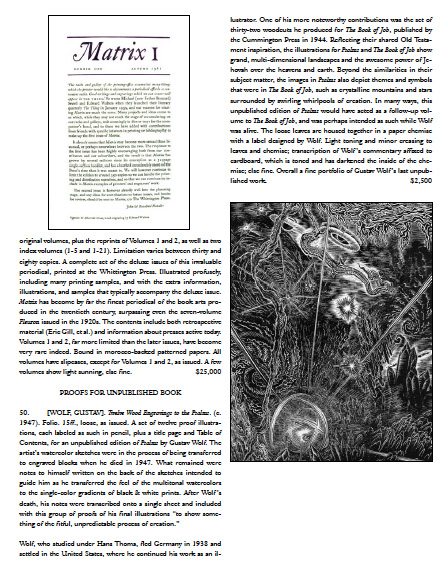
Bromer Booksellers Catalogue 144, page 11
I’d become fascinated with Wolf ever since the Baltimore Museum of Art (BMA) purchased in 2015 his portfolio Welt (World) of 12 large and dramatic woodcuts. As often happens when I learn of artworks that excite me visually, I turned to the computer to find out more about the artist and where his artworks may be available. I found a listing for individual signed prints from Welt on the website of a German gallery. But for a price one needed to make a request. I did twice but got no answer.
I also found an online listing for Gustav Wolf on the website for an American print dealer. When I clicked on the name, all I got was the phrase: “Coming soon.” So I called the dealer. He said he had a number of things, but he was swamped doing shows and dealing with family concerns. He hoped to get to the Wolf prints soon, but never did in 2015. So that put things on hold until the Bromer catalog arrived.
The folks at Bromer were very good in sending me jpegs of several plates plus a page of text that was a transcription of notes that Wolf left on the back of watercolors that served as his sketches for the wood engravings. Wolf, who suffered from diabetes, died before The Psalms could be published. What Bromer was offering was a set of proofs. Nice, but at $2,500 I kept my finger off the trigger.
But their availability served as a catalyst for me to renew my Wolf quest.
Madness begin
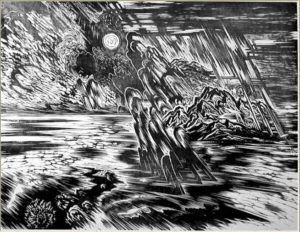
Gustav Wolf, Plate 5 from Welt, 1927-29, woodcut, image 15 1/2″ x 20 3/8″
First and foremost, I had some money to spend in mid-March, when I returned from a month’s artist residency in India. There’s nothing like having prepaid holiday to build up a discretionary nest egg. First I tried the folks at German gallery again. This time (April 1) I got prices on the nine individual Welt prints they had. Seven were €250; two were €400. Together the nine were offered at €1,700. Then the proprietor said he had a complete set of Welt that wasn’t listed on the website. “I just got it,” he said. “Found it in my father’s estate.” He offered that at €3,000, or €4,200 if I bought the set plus all of the individual plates. You see how things mushroom? Yet, I wasn’t sure I wanted Welt, either whole of in pieces. Once the BMA has something, my interest flags–as if I’m competing with the museum’s pocketbook.
So I try the American dealer again a week later. This time the dealer has the time to search for Wolf items. Previously, he said, “I have been consumed by the job of settling my Dad’s estate and cleaning out a house and three-story barn of a lifetime accumulation. I need to sort through everything because they were also dealers in antiques, books and art. Being the only child makes this a monumental task.” Now he provides me with images from three Wolf portfolios. He says: “Provenance for all the Gustav Wolf material is Lola Wolf, the artist’s widow. I purchased them directly from her.” And he starts to provide me with images for Die Blätter vom Lebendigen Sein (Plates of the Living Being), 7 plates, 1918-22; Zehn Holzschnitte (10 Woodcuts), 1910; and Zehn Worte Des Anfangs (10 Words of the Beginning), 1928-29.
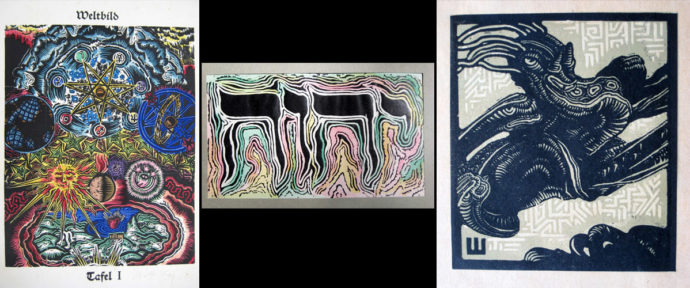
Left to Right
Die Blätter vom Lebendigen Sein, 1918-22, Plate 1 Weltbild (World Image), hand-colored woodcut, 15 1/2″ x 12 1/4″ (portfolio price $2,500)
Zehn Worte Des Anfangs, 1928-29, Plate 11 Der Name, hand-colored woodcut, 7″ x 12 1/4″ (portfolio price $750)
Zehn Holzschnitte, 1910, plate V, color woodcut, 4 1/8″ x 3 5/8″ (portfolio price $1,000)
I like the scale and power of Die Blätter vom Lebendigen Sein, but I’m not sure of the color. The dealer says the portfolio was issued with 50 sets hand-colored and 200 sets without color. All plates are signed in both sets. Again the $2,500 price makes me hesitate. But knowing the name of this Wolf portfolio is sufficient to set me off on a AbeBooks.com search. Sure enough a German dealer has an uncolored set, and the price is €400 with expedited shipping. So my first portfolio was bought 21 April 2016.
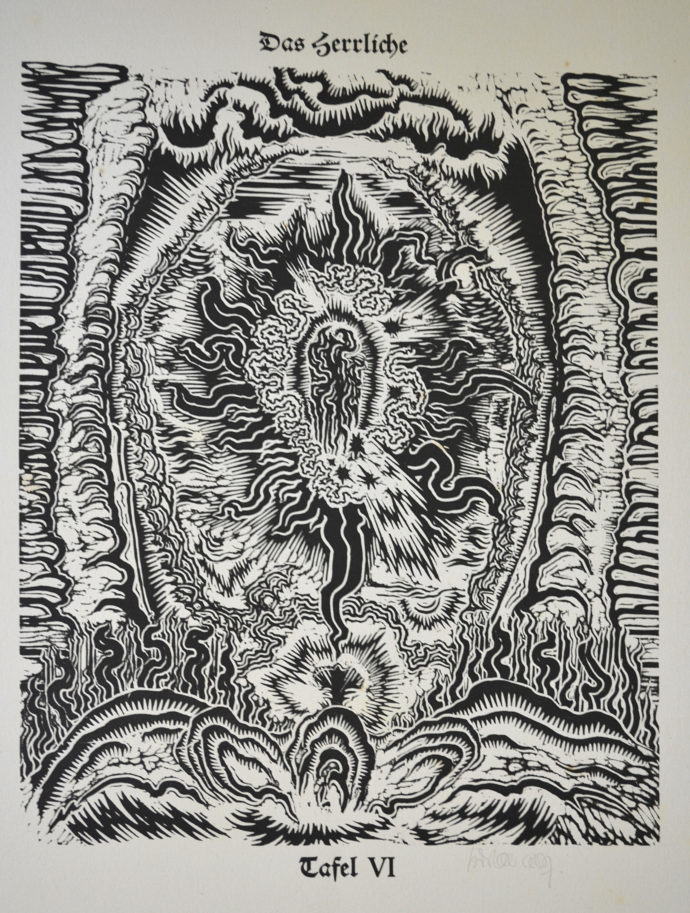
Gustav Wolf, Das Herrliche (The Beautiful), Tafel VI from Die Blätter vom Lebendigen Sein, 1918-22, woodcut, 21 1/2″ x 17 3/4″
Second Portfolio
So flush from my first portfolio purchase that barely put a dent in my discretionary nest egg, I turn to a recently passed-up opportunity. At the Capital Print Fair, the first weekend in April, I came across Crucifixion, a powerful but very difficult wood engraving by the artist Fritz Eichenberg (German-born American, 1901-90).
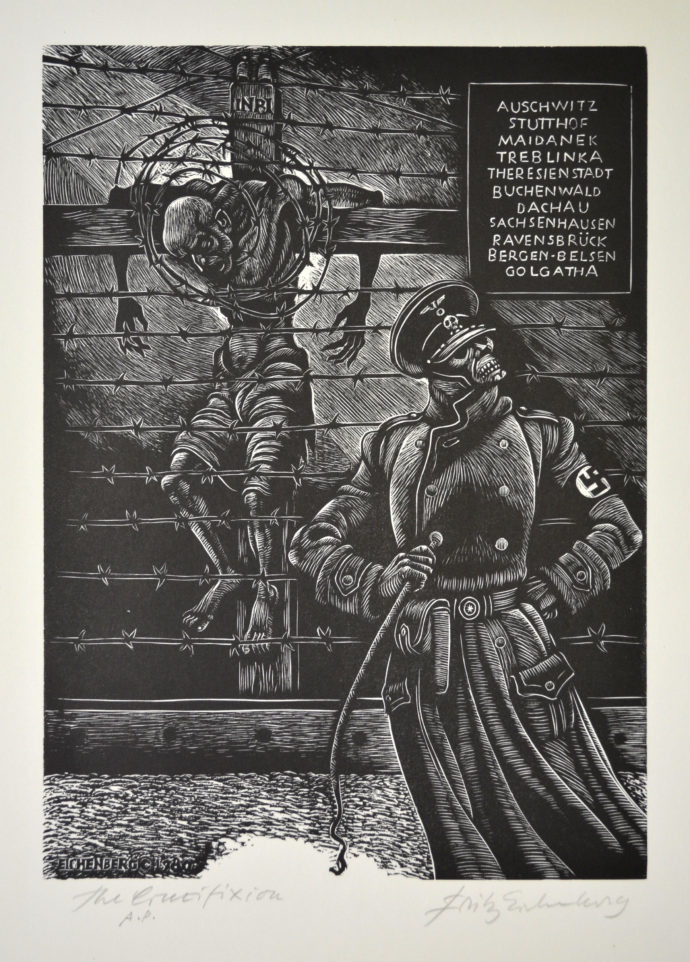
Fritz Eichenberg, Crucifixion, 1980, wood engraving, artist proof, 15″ x 9″
I think the price is $575, which is a bit much for all-but-the-earliest Eichenbergs but a lot less than a current online offering at $1,800. So I show the print to the dealer, and he says I can’t buy it separate from the portfolio of 17 prints called Dance of Death. He asks $3,000 for the set, which is assembled, i.e. about half are numbered 2/50; the rest are artist proofs. But all images are present and signed.
Now fast forward to the day after I bought the Wolf portfolio. I phone this dealer and offer $2,500 for the Eichenbergs. He grumbles for a moment or two but agrees to my offering and includes shipping. Once the negotiations pass, I mention to him how this acquisition comes a day after my Gustav Wolf purchase. Hearing this, the dealer that he has some Wolfs too. He can’t remember what, and he’s not sure where they are. But he’ll look for them and get back to me.
WOLF FEVER
Ecstatic over my two new portfolios, I invite a print curator from the BMA over to see them. After I turn each huge plate of Die Blätter vom Lebendigen Sein over, I show on my laptop the nearly psychedelic hand-colored version. It makes for a nifty ooh-and-ah session. But we both agree that the black-and-white versions are more powerful.
A week or two later I visit the BMA to see their copy of Gustav Wolf: Das Druckgraphische Werk, the 1982 catalogue raisonné by Johann Eckart von Borries. It’s a bit underwhelming visually, but all the information is there albeit in German. I don’t take notes, but I do go online and buy a copy.
The horizon is quiet for a month or so. Until the day I altered my search (I don’t remember what I did) and landed on the eArt.de website, which features mostly German art. Sure enough, there’s two portfolios by Gustave Wolf offered by the same dealer: a large one in woodcuts called Confessio, Worte und Zeichen (Confession, Words and Characters), 1908, and a more delicate one in lithographs called Am Anfang/Genesis (At the beginning/Genesis), 1913.

Left to Right
Confessio, Worte und Zeichen, 1908, woodcuts, 11 plates, edition 250, portfolio size 25 5/8″ x 19 5/8″
Am Anfang/Genesis, 1913, edition 250 (the first 50 hand-colored), Der dritte Tag (The Third Day) and Der siebente Tag (The Seventh Day), portfolio size 20″ x 16″
Here was where having the catalogue raisonné was handy. I could see that only four of the eleven Confessio plates were text-free, while the Am Anfang/Genesis portfolio was a rare case of Wolf using lithography. It also was related to Die Blätter vom Lebendigen Sein in that both utilize seven plates to express a Genesis progression. While the dealer offered both for €700 with shipping instead of €440 and €360 individually, I chose to just buy Am Anfang/Genesis for €350 with shipping. That was 21 June 2016.
So you see, I wasn’t so crazed for Wolfs that I needed them all.
FINAL SPREE
I did suffer a little anxiety attack because Am Anfang/Genesis didn’t arrived until 30 June. At which time I casually asked whether the dealer was just selling of a few items from his collection or was he a full-time print dealer. He answered: “Art trading is my business.” So I asked him to keep an eye out for “a very early woodcut edition of Alfred Rethel’s Ein Todtentanz, also Max Thalmann’s Der Dom [The Cathedral] or signed plates from his Amerika im Holzschnitt. I have the book.”
What I wasn’t prepared for was this answer on 6 July: “I can offer Thalmann’s DOM portfolio (complete including envelop) as one of the 250 unsigned pieces (700 euros).” I request photos and don’t hear from him immediately.
In the mean time I remember that I hadn’t heard from the American dealer who sold me the Eichenbergs. Did he find the Wolfs that he thought he had? Two days later he calls with the news that he has a complete set of Gustav Wolf’s Twelve Wood Engravings to The Psalms individually matted. On 12 July he offers them for $900, a great discount from the Bromer set. Later that day he sends images of the title page and the 12 plates. I compare them to the catalogue raisonné and the Bromer-supplied images. They’re better than the Bromer ones, and each has a pencil inscription well below the image. It reads: “Last work by Gustav Wolf, printed posthumously by Mrs. Gustav Wolf.” (I wonder if she actually printed them or only authorized and supervised their printing.) I call back 13 July and he accepts my offer of $800 with shipping.
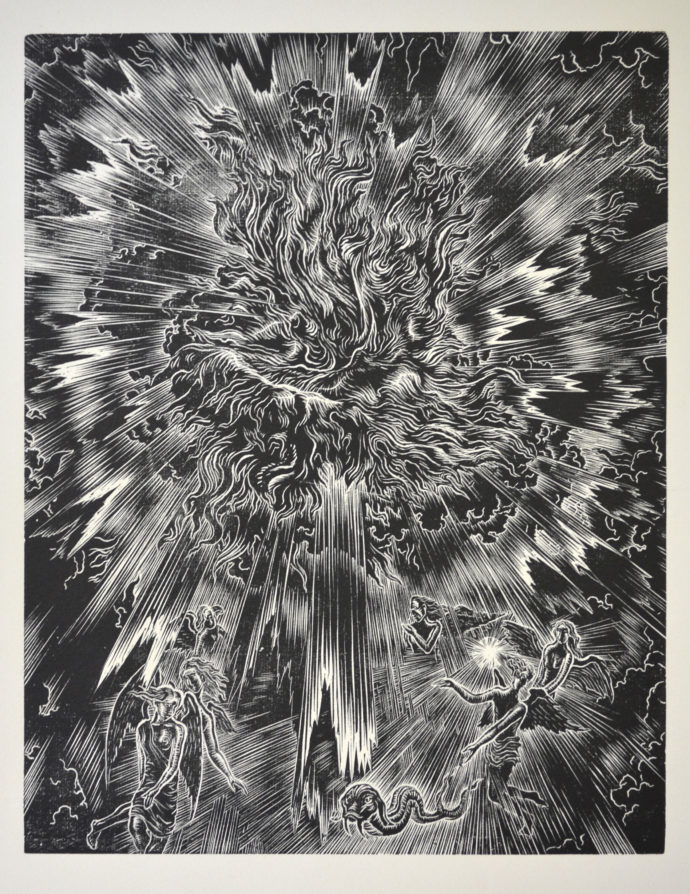
Gustav Wolf, Twelve Wood Engravings to the Psalms, Plate 5, Psalm 139.7, wood engraving, 14″ x 11″
The very next day I get this email from the German dealer: “I was on a short trip, so sorry for the delay. Unfortunately I can’t find the portfolio in my storage loft, where it should be(?) but I can offer my personal one with the plates individually signed in pencil (initials), in very good+ condition (first two plates slightly foxed with folds upper right) and incl. the foreword by G.F. Hartlaub and the original brown wrappers (950 euros).” And he sends images of several plates, the portfiolio cover, and a close-up of the initials. The latter I compare to the signatures on an online set of Der Dom plates.

Max Thalmann (German, 1890-1945), Der Dom, 1922, set #59 with 10 woodcuts, initialed, 19 1/2″ x 14 3/4″
I should note that like the published Wolf portfolios Thalmann’s Der Dom portfolio numbered 250 sets. Both Wolf and Thalmann divided the sets into the first 50 and the later 200. In Wolf’s case he often hand-colored the first 50 and issued the rest un-colored. But he signed all the plates in all 250 sets. Thalmann, on the other hand, signed each plate only for the first 50 sets.
Naturally, I tried to drop the price, but he rebukes me: “Please note it’s an important work of art in fantastic state. Lets say 940 incl. shipping (and minus PayPal fees, taxes…). Hope this is OK with you!” It’s OK with me and pay on 21 July.
This portfolio splurge–five purchases in 4 1/2 months–better be over now, I tell myself. So I dare not ask any dealer any time soon: “Do you happen to have….”
Aesthetics
Well, there’s no hiding the fact that I really get off on relief prints. I just love the energy artists like Gustav Wolf and Max Thalmann can create in the clash of blacks and the whites. What both artist share besides their German heritage is their evident strong religious feelings. Wolf was Jewish. (Fortunately he and his wife escaped Germany in 1938.) His portfolios Welt, Die Blätter vom Lebendigen Sein, and Am Anfang/Genesis are all Old Testament creation cycles. And Twelve Wood Engravings to the Psalms sings the praise of God again and again. Thalmann expressed the Christian beliefs in Der Dom and Passion portfolios. You can’t overlook his feelings of religious ecstasy in the plate above.
A year after Der Dom was published he made a trip to the United States and so taken with the skyscraper canyons of New York that he created two woodcut portfolios: Rhythmus der Neue Welt (Rhythms of the New World) with 10 plates and Amerika in Holzschnitt (America in Woodcuts) with 30 plates. The woodcuts of Rhythmus are rather geometric with straight edges and right angles; while the Amerika woodcuts are cut more feverish and ragged in the best German Expressionist fashion.
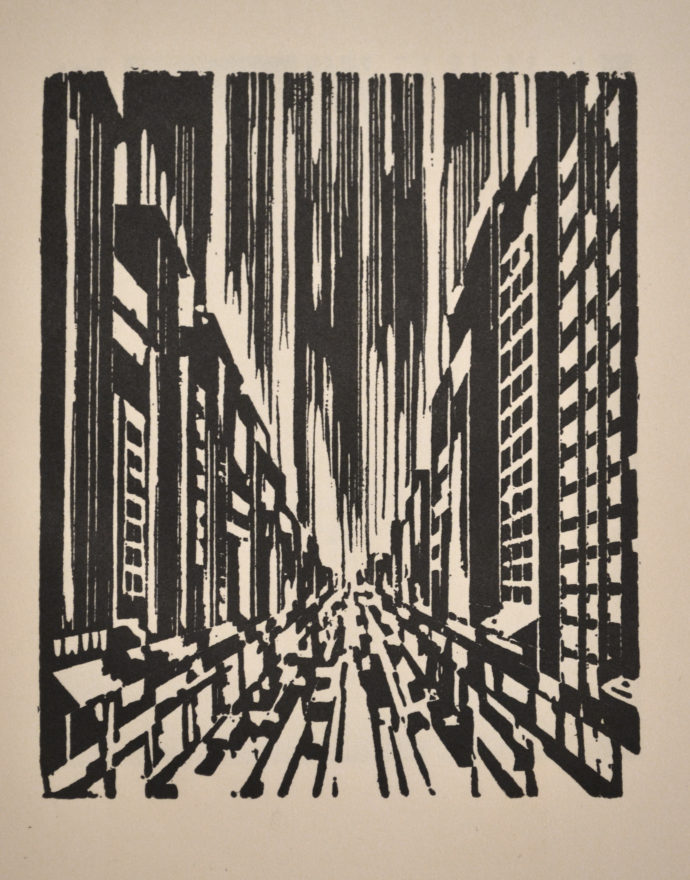
Max Thalmann, Amerika in Holzschnitt, the book, Plate #6 Nord-Sud, Studentweit, reproduced woodcut, 6 5/8″ 5 1/2″
The plate above is from the 1927 book Amerika in Holzschnitt with 24 plates chosen from both portfolios. It shows Thalmann’s Expressionist fervor in cutting the block. I sense that Thalmann in the streets of Manhattan felt an ecstasy there similar to what he felt in Gothic German cathedral. Was Manhattan his new church?
A great amount of Thalmann material resides at the Loyola Marymount University, Department of Archives and Special Collections, William H. Hannon Library, Los Angeles, CA. According to the Online Archive California page for the Max Thalmann Collection: “Upon his return to Europe, he left his collection with his brother with dreams of someday moving to the United States, but he never did.”
Fritz Eichenberg, however, was raised in a non-religious Jewish family in Germany. He and his family emigrated to the U.S. in 1933. He certainly recognizes the influence of religion, but in his art he usually kept it at an emotional distance. Crucifixion from his Dance of Death portfolio was a dramatic exemption. He appropriated the Christian symbol of the cross to stress how millions of Jews each became the new sacrificial lamb.
LINKS
Max Thalmann
The link to the OAC Thalmann page is: http://www.oac.cdlib.org/findaid/ark:/13030/c8mw2mjf/entire_text/ Under “Additional collection guides” is a link to a PDF of the items in the collection.
Images to some of his Amerika woodcuts and all of his Dom woodcuts can be found at: http://socks-studio.com/2016/04/02/max-thalmanns-america-in-woodcuts-1925-and-the-cathedral-1922/
Gustav Wolf
There’s a museum devoted to Wolf in Östringen, Germany. It has no separate website and certainly no gallery of Wolf artworks. Here’s the link to the Wolf page at the town’s website: http://www.oestringen.de/kultur_freizeit/detail.php?rubric=77&nr=1455 The Wolf page talks about how in the 1980s the town’s mayor reached out to Wolf’s widow Lola with the promise to create a museum devoted to her husband.
The Arts in Exile website has a page–http://kuenste-im-exil.de/KIE/Content/EN/Persons/wolf-gustav-en.html–on Wolf. Below the text is a thumbnail image from his 1941-42 etching portfolio Vision of Manhattan. Click on the image and you can see the complete portfolio. Above the thumbnails is a short bibliography on Wolf.
Fritz eichenberg
Useful information can be found on his Wikipedia page: https://en.wikipedia.org/wiki/Fritz_Eichenberg
Eichenberg worked with Dorothy Day and contributed mightily to her publication The Catholic Worker. To learn more about this collaboration, go to: http://sacredartpilgrim.com/collection/view/19
Many print dealers carry his work. So just google the name.
Trackback URL: https://www.scottponemone.com/diary-of-portfolio-madness/trackback/










